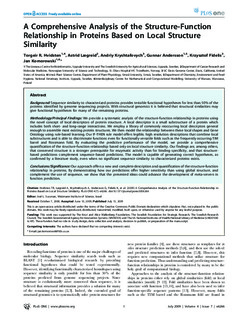| dc.contributor.author | Hvidsten, Torgeir | |
| dc.contributor.author | Lægreid, Astrid | |
| dc.contributor.author | Kryshtafovych, Andriy | |
| dc.contributor.author | Andersson, Gunnar | |
| dc.contributor.author | Fidelis, Krzysztof | |
| dc.contributor.author | Komorowski, J | |
| dc.date.accessioned | 2015-10-29T13:39:58Z | |
| dc.date.accessioned | 2016-03-11T14:15:02Z | |
| dc.date.available | 2015-10-29T13:39:58Z | |
| dc.date.available | 2016-03-11T14:15:02Z | |
| dc.date.issued | 2009 | |
| dc.identifier.citation | PLoS ONE 2009, 4(7):e6266 | nb_NO |
| dc.identifier.issn | 1932-6203 | |
| dc.identifier.uri | http://hdl.handle.net/11250/2382089 | |
| dc.description.abstract | Background:Sequence similarity to characterized proteins provides testable functional hypotheses for less than 50% of the
proteins identified by genome sequencing projects. With structural genomics it is believed that structural similarities may
give functional hypotheses for many of the remaining proteins.
Methodology/Principal Findings:We provide a systematic analysis of the structure-function relationship in proteins using
the novel concept of local descriptors of protein structure. A local descriptor is a small substructure of a protein which
includes both short- and long-range interactions. We employ a library of commonly reoccurring local descriptors general
enough to assemble most existing protein structures. We then model the relationship between these local shapes and Gene
Ontology using rule-based learning. Our IF-THEN rule model offers legible, high resolution descriptions that combine local
substructures and is able to discriminate functions even for functionally versatile folds such as the frequently occurring TIM
barrel and Rossmann fold. By evaluating the predictive performance of the model, we provide a comprehensive
quantification of the structure-function relationship based only on local structure similarity. Our findings are, among others,
that conserved structure is a stronger prerequisite for enzymatic activity than for binding specificity, and that structurebased predictions complement sequence-based predictions. The model is capable of generating correct hypotheses, as
confirmed by a literature study, even when no significant sequence similarity to characterized proteins exists.
Conclusions/Significance:Our approach offers a new and complete description and quantification of the structure-function
relationship in proteins. By demonstrating how our predictions offer higher sensitivity than using global structure, and
complement the use of sequence, we show that the presented ideas could advance the development of meta-servers in
function prediction. | nb_NO |
| dc.language.iso | eng | nb_NO |
| dc.publisher | Public Library of Science | nb_NO |
| dc.title | A comprehensive analysis of the structure-function relationship in proteins based on local structure similarity | nb_NO |
| dc.type | Peer reviewed | nb_NO |
| dc.type | Journal article | |
| dc.date.updated | 2015-10-29T13:39:58Z | |
| dc.description.version | publishedVersion | |
| dc.source.volume | 4 | nb_NO |
| dc.source.journal | PLoS ONE | nb_NO |
| dc.source.issue | 7 | nb_NO |
| dc.identifier.doi | 10.1371/journal.pone.0006266 | |
| dc.identifier.cristin | 343243 | |
| dc.description.localcode | This is an open-access article distributed under the terms of the Creative Commons Public Domain declaration which stipulates that, once placed in the public domain, this work may be freely reproduced, distributed, transmitted, modified, built upon, or otherwise used by anyone for any lawful purpose. | nb_NO |
